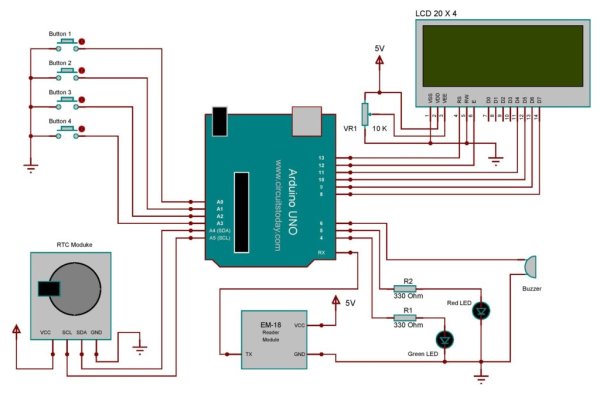
A hand-held inventory reader can be moved rapidly across a shelf of books to read all of the unique identification information. Staff is relieved further when readers are installed in book-drops.Ī unique advantage of RFID systems is their ability to scan books on the shelves without tipping them out or removing them. Patron self check-in shifts that work from staff to patrons. For patrons using self check out, there is a marked improvement because they do not have to carefully place materials within a designated template and they can check out several items at the same time. The time savings are less for check-out than for check-in because the time required for check-out usually is extended by social interaction with patrons.
Rfid reader proteus library how to#
How to Add Arduino Library in to Proteus 7 & 8 There can be as much as a 50 percent increase in throughput. The other time savings realized by circulation staff are modest unless the RFID tags replace both the EM security strips or RF tags of older theft detection systems and the barcodes of the library management system - i. While initially unreliable, the anti-collision algorithm that allows an entire stack to be check-out or check-in now appears to be working well. The most significant time savings are attributable to the facts that information can be read from RFID tags much faster than from barcodes and that several items in a stack can be read at the same time. The use of RFID reduces the amount of time required to perform circulation operations. The corridors at the building exit s can be as wide as four feet because the tags can be read at a distance of up to two feet by each of two parallel exit sensors. The information contained on microchips in the tags affixed to library materials is read using radio frequency technology regardless of item orientation or alignment i. RFID is a combination of radio-frequency-based technology and microchip technology. We just need to control ENABLE and RS pins to send characters and data accordingly.Unlike EM Electro-Mechanical and RF Radio Frequency systems, which have been used in libraries for decades, RFID-based systems move beyond security to become tracking systems that combine security with more efficient tracking of materials throughout the library, including easier and faster charge and discharge, inventorying, and materials handling. This puts LCD in highest contrast and read mode.

The contrast bit and READ/WRITE are not often used so they can be shorted to ground. In the circuit, you can observe that I only took two control pins as his give the flexibility of better understanding.

Now in the 14 pins there are 8 data pins (7-14 or D0-D7), 2 power supply pins (1&2 or VSS&VDD or GND&+5v), 3 rd pin for contrast control (VEE-controls how thick the characters should be shown) and 3 control pins (RS&RW&E). One can power or leave the back light pins. In 16×2 LCD there are 16 pins over all if there is a back light, if there is no back light there will be 14 pins.

Hardware: ARDUINO UNO, power supply (5v), 100uF capacitor, buttons (two pieces), 1KΩ resistor (two pieces), EM-18(RFID reader module), LED, JHD_162ALCD (16*2LCD).

Some schools and colleges nowadays use RFID as attendance register. The RFID authentication systems are easy to design and are cheap in cost. The RFID tag is designed as small as grain of sand. These systems have many applications, like in offices, shopping malls and in many other places where only the person with authorization card is allowed to enter in the room. RFID is used in shopping malls to stop a theft from happening, here the product will be tagged with RFID chip and when a person leaves a building with the RFID chip an alarm is raised automatically and so the theft is stopped. Each card has a unique ID embedded in it. RFID stands for Radio Frequency Identification. In this tutorial we are going to design a system to read the ID of RFID cards.


 0 kommentar(er)
0 kommentar(er)
